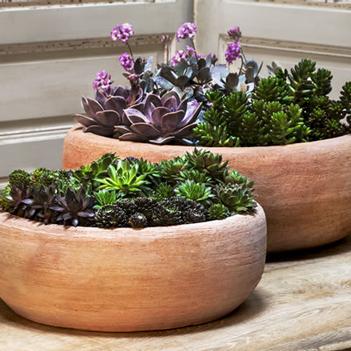Container gardening offers many advantages that can be overlooked: containers can be less work because they can be placed closer to a water source; they offer a smaller soil area to have to weed; they can be placed at a height that can minimize bending for watering and tending; movable containers can “follow the sun” if you have changing exposure; they can provide a garden plot even in apartments or homes with no space for a traditional garden; and just about any plant—flower or vegetable—can be grown in a container.
Virtually anything that will hold soil and water is a candidate for container growing. From a bag of soil with holes punched for planting and drainage to wooden tubs, old riding boots, milk cans, hanging baskets and fancy ornamental pots. You can choose the size, shape and cost to fit your needs and desires. Here are a few things to keep in mind:
- The deeper the pot the less watering it will need. Pots with a small soil volume will dry out faster and require more frequent watering.
- Scale is important. Look through photos of container plantings and more often than not, bigger is better when placing a combination planter on a porch or patio.
- Plants in pots or hanging baskets are exposed on all sides to the drying effects of wind and sun. On hot, windy days you may have to water them more than once.
- Darker colored containers will absorb more heat, which can get seeds and transplants off to a faster start, but these containers will need more watering if they are in direct sunlight. Lighter colored containers might be a better choice for most people.
- Select a container that will give your plant’s roots room to grow, but not so much that it will not fill out the pot. Consider the mature size of the plants you will be growing, and follow the spacing recommendations on the seed packet or plant label.
- Unglazed clay containers, such as terra cotta, may seem more natural or appeal to those who want a certain look, plastic containers offer an advantage if they are to be placed in full sun. Unglazed clay pots are porous and water can quickly evaporate from them, while plastic containers do not “breathe” and therefore they will not need watering as often as clay.
- Be sure that your container allows for drainage. If the pot doesn’t have a drainage hole in the bottom, add one. If you don’t want to put a hole in a decorative ceramic container you can simply put a smaller pot inside the decorative one, being sure there is some room at the bottom for water to drain out.
















